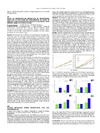Please use this identifier to cite or link to this item:
https://accedacris.ulpgc.es/handle/10553/37105
| Title: | Effect of intraarticular inoculation of mesenchymal stem cells in dogs with hip osteoarthritis by means of objective force platform gait analysis. Concordance with numeric subjective scoring scales | Authors: | Cuervo Serrato, Belén Carrillo Poveda, José M. Rubio Zaragoza, Mónica Sopena Juncosa, Joaquín Dominguez Pérez, Juan M. Vilar Guereño, José Manuel |
UNESCO Clasification: | 310907 Patología | Keywords: | Mesenchymal stem cells Force platform Visual analog scale Pain assessment Osteoarthritis, et al |
Issue Date: | 2017 | Journal: | Osteoarthritis and Cartilage | Conference: | World Congress of the Osteoarthritis-Research-Society-International (OARSI) on Osteoarthritis | Abstract: | Intensity of pain is difficult to accurately assess in dogs. Veterinarians assess the severity of pain in their patients using scoring systems based on several signs, including patient vocalization, activity level, degree of lameness, and reaction to manipulation. However, all of these signs are subjective and may be influenced by a variety of external factors. Subjective pain assessment scales have been widely used for assessing lameness in response to pain, but the accuracy of these scales has been questioned. For this reason, the objective of this study was to evaluate the concordance between subjective measures of pain as scales (Bioarth and visual analog scale (VAS)), and objective measures of pain as the force platform (peak vertical force, PVF, maximal force applied during stance phase; and vertical impulse, VI, total force applied over time), of limb function in dogs of the same breed that had osteoarthritis (OA) lameness due to bilateral hip dysplasia and were treated with autologous mesenchymal stem cells (MSCa) Methods: To carry out this clinical study, ten adult, client-owned Presa Canario dogs (6 males, 4 females) with lameness and pain attributed to OA associated with hip dysplasia were included. A control group consisted of 5 healthy dogs of the same breed. The sample size was selected based on the availability of the subjects of the same breed, same pathology and similar degree of severity in order to achieve a study group with maximal homogeneity. None of the dogs were forced to perform physical activity. The dogs were first treated with MSCa. Then, at basal and month 1, 3 and 6,the potential lameness improvement was evaluated with Bioarth and VAS. These data were compared with similar data collected using a force platform with the same animals during the same period, basal,1, 3 and 6 months after treatment. Results: The body weight of the enrolled dogs ranged from 46 to 65.2 kg (mean ± SD: 51.21 ± 5.48 kg), and ages were 4 − 9 years (mean: 5.6 ± 2.3 years). Walking speed of both healthy (control) and diseased groups of dogs was 1.6 ± 0.5 m/s. No significant differences in walking velocity was observed between dogs (P = 0.08). The F test for intraclass correlation showed that concordance in pain/lameness scores between the 2 measuring methodologies was not significant (P value ≥ 0.9213; 95 % confidence interval, −0.56, 0.11) (Table 1). Although subjective pain assessment showed improvement after 6 months, force platform data proved those same animals had returned to the initial lameness state (Figure 1 and 2). Conclusions: Pain is an emotional response to a painful stimulus and is difficult to reliably determine in a nonverbal animal. Pain of the locomotor system can usually be detected by a certain disability to support weight; in other words, lameness is the expression of pain. MSC therapy significantly improved limb function in dogs with hip OA, but the duration of the improvement was inferior to 6 months post treatment. Subjective evaluation of gait correlates poorly to objective measures of limb function. For this reason, subjective evaluation of gait should be interpreted cautiously as an outcome measure. | URI: | https://accedacris.ulpgc.es/handle/10553/37105 | ISSN: | 1063-4584 | DOI: | 10.1016/j.joca.2017.02.659 | Source: | Osteoarthritis and Cartilage [ISSN 1063-4584], v. 25 (S1), p. S385 |
| Appears in Collections: | Actas de congresos |
Items in accedaCRIS are protected by copyright, with all rights reserved, unless otherwise indicated.
